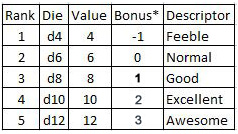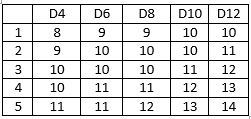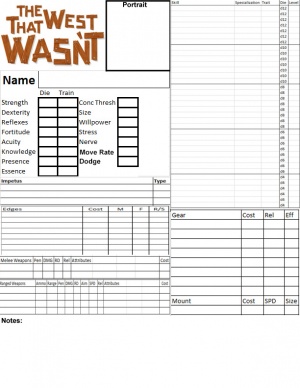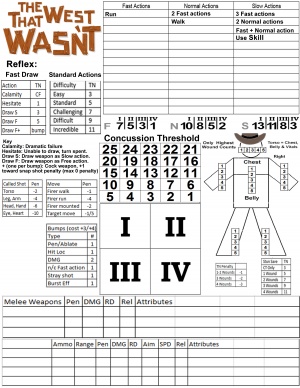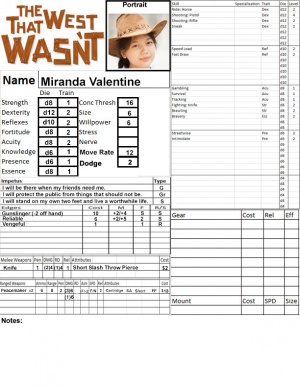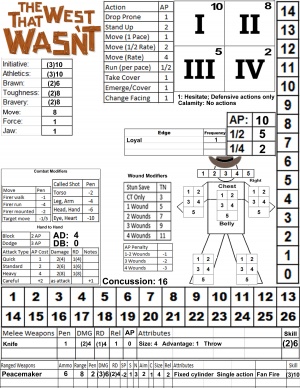The West That Wasnt - Character Generation
Contents
Character Generation
In The West That Wasn’t, each player will create a character to play in the game. Characters are built mechanically from a pool of points which are exchanged for Traits, Skills and Edges based on the rules presented in this chapter. Outside of mechanics, players are encouraged to provide personality, history and motivation for their character as well.
Standard character power level is 100 points. Depending on the scope of the game, the Judge may assign a different number of points. In most situations all characters begin the game with the same number of points. See the From the Bench chapter for more on determining character power level and varying between characters.
Traits
Traits are the measure of how well the character interacts with The West. There are 8 primary Traits in TWTW; 4 “physical” Traits and 4 “intangible.” These form the basis of the range of physical, perceptive and intellectual capabilities of a character. Each trait has a die type from d4 to d12.
Traits have a value, which is equal to the highest number on their given die type, and a bonus which is represented on the table above. Each Trait has a Trait Skill that is used when no applicable skill exists. This skill has a rank just like other skills. See Chapter 2.1, Skill List, for more on Trait Skills. Note that Trait Skills are only used when the skill does not exist, not when a character has no level in a given skill. Additionally, add 1 to the Bonus for each rank above 3 in the Trait Skill.
Traits provide the effectiveness of the interaction between a character and The West. A stronger character is better at interacting using Strength, such as when lifting a stone, swinging an ax or climbing a cliff face. Along with the 8 primary Traits assigned by the Player, there are 8 other attributes derived from the values of the primary Traits.
Physical Traits
The physical traits relate to the body of the character. What can the character do? Physical traits are easily measured or quantified.
Strength
Strength is a measure of brawn and ability to use it. Strength checks and tests are important when moving things, carrying things and when doing damage with melee weapons. The Strength trait determines how much a Hero can lift and carry (Chapter XX). Trait Skill: Brawn.
Dexterity
Dexterity is body control, physical precision and lithe deftness of a Hero. Some examples of Dexterity in action are firing ranged weapons, doing precise manual tasks quickly and movement. Dexterity determines the movement speed of the Hero. Trait Skill: Athletics.
Reflexes
Reflexes are the quick reactions and instantaneous movements of a Hero. The most common application of Reflexes is initiative during combat, but it can also be used with the Fast Draw skill, as well in other types of physical contests. Trait Skill: Initiative.
Fortitude
Fortitude is the physical toughness and pain threshold of the Hero. Fortitude is used in stun checks, as well as resisting disease and other effects of physical damage. Fortitude contributes to Concussion Threshold (below). Trait Skill: Toughness.
Intangible Traits
Intangible traits are much more difficult to measure. They constitute processes which are largely invisible to normal senses (or they are senses themselves!).
Acuity
Acuity is the mental alertness as well as aptitude of a Hero. Acuity is used when searching for something, as well as noticing something passively. Trait Skill: Awareness.
Knowledge
Knowledge is the sum of the education of the Hero as well as the application thereof. Knowledge is the basis for solving engineering and science problems, and also includes memory. Trait Skill: Education.
Presence
Presence is the will of the Hero as well as the ability to project that will into the world at large. Presence is used in initiating and resisting psychological contests (Chapter XX). Trait Skill: Verve.
Essence
Essence is that extra something that asserts itself in times of need. Essence is used for bravery, as well as for mystical abilities. Trait Skill: Spirit.
Action Points
Action points are a measure of how much a character can do during action time, such as in combat. Each character has a pool of points that can be used each round, from 8-14, with most characters having 10. See the following chart for AP allocation.
Action points are allocated based on the lower of the Dexterity or Reflexes trait.
Trait Cost
| Rank | Cost |
| 1 (d4) | x |
| 2 (d6) | 0 |
| 3 (d8) | 3 |
| 4 (d10) | 6 |
| 5 (d12) | 10 |
Trait Skill Ranks
The following table provides costs for purchasing Trait Skill Ranks.
| Rank | Cost |
| 1 | 0 |
| 2 | 2 |
| 3 | 3 |
| 4 | 7 |
| 5 | 12 |
Derived Attributes
Some attributes are not purchased directly, but rather are derived from two or more other traits. The values of these attributes cannot normally be raised directly, though some may have Edges that can affect them. These Edges can only be purchased during character generation, except in extraordinary situations (Judge's discretion).
Concussion Threshold
Concussion Threshold (CT) is a derived attribute that combines Fortitude and Essence trait values. This represents the amount of shock, fatigue, or trauma your character can take before keeling over. To determine CT, add the value of the die type of the character’s Fortitude and Essence Traits. A character with rank 3 (d8) Fortitude and rank 2 (d6) Essence would have a CT of 14 (8+6).
When CT is reduced to zero or less the character is effectively out of the action. There may be circumstances when the Judge may allow limited actions, but in general, the concussed Hero is down for the count. They do not roll Reflexes nor draw cards during the combat phase. If forced to test a physical trait, the result is 0. Intangible traits are at Judge's discretion (but generally 1d4).
Stress
Stress is the measure of the character's mental wherewithal, and is used like CT against psychological attacks. A character who is reduced to zero Stress is worn out. Stress is equal to the die type values of Presence plus Essence. More on psychological attacks and stress in chapter XX.
Size
Size is the measure of how easily wounds are dealt to a character. When assessing damage, you will take one wound per multiple of your size that is dealt in damage effect. To determine size, add the rank for the character’s Brawn and Toughness. Most characters will have a size of 6.
| Brawn + Toughness Rank | Size |
| 2-3 | 5 |
| 4-8 | 6 |
| 9-10 | 7 |
Willpower
Willpower is resistance to psychological effects in verbal or social engagements. It can be compared to the Size Attribute, above, but used against a different type of damage. Willpower is determined by adding the character’s Verve and Education rank and consulting the following table. Most characters will have a willpower of 6.
| Verve + Education Rank | Willpower |
| 2-3 | 5 |
| 4-8 | 6 |
| 9-10 | 7 |
Nerve
Nerve is the character’s defense against fear, compulsion and other psychological attacks. How it is derived will be determined when the section on Social Combat is complete.
Active Defense
This derived attribute determines how well a character can spot incoming attacks and how quickly they can move to avoid them. When a character takes a dodge action in combat, their Active Defense (AD) is added to the TN of all attackers. Active Defense is equal to the rank of the Initiative skill.
Rate
This determines how far the character can easily move on foot in one action round. Rate is equal to the value of the character's Dexterity trait in paces per turn. All normal movement up to the Rate costs 1 AP. Further movement costs 2. Running movement costs 1/2 AP up to the rate, 1 AP thereafter.
Damage Bonus
The Damage bonus (DB) is the extra damage a character does when using hand to hand weapons or attacks. Damage Bonus is equal to the Bonus value of the character's Brawn.
Hand to Hand Penetration
The Hand to Hand Penetration (HP) value is used when attacking unarmed. It is compared to the Hand to Hand Armor value, as described in the combat section of the rules. HP is equal to 1 + the bonus value of Strength, and is only used versus unarmored characters and those without cover. In cases of armor or cover, all characters have a penetration value of 0.
Hand to Hand Armor
Hand to Hand Armor value (HA) is compared to HP to determine whether a hand to hand attack penetrates. HA is only usable versus unarmed attacks and blunt weapons, and is equal to the bonus value of Fortitude.
Skills
Skills determine the specific abilities and knowledge a character possesses. Skills are ranked from level 1 to 5. When using a skill, determine the associated Trait being used (more on this in chapter XX: Skills). This will determine which column you refer to on the cause table of the action card. The level of the skill determines the rows within that column you would refer to. See the Action Resolution chapter for more on using Skills.
Skills are purchased with character points according to the following table:
| Skill Level Cost | |
| 1 | 2 |
| 2 | 4 |
| 3 | 7 |
| 4 | 12 |
| 5* | 18 |
*Skills at level 5 may not be purchased during character creation, but skills can be improved to level 5 with experience.
Untrained Skill Use
Sometimes a character will be called upon to use a skill they have no training with, or they may try to muddle through a task, hoping their natural abilities will carry them to success. In these cases, use the rank of the character's associated trait skill in the d4 column. Miranda Valentine, with a 2d12 Dexterity, uses the 2d4 entry when performing untrained Dexterity related skills.
Skill Specializations
Some skills have associated specializations. These can be purchased for 3 character points each. When using the specialization for a skill, if the skill roll succeeds, the player earns one free Bump. (For more on Bumps, see Chapter XX: Skills)
Edges
Edges come in two varieties: Rough and Sharp. Rough edges are a character’s weaknesses, foibles, peculiarities or flaws. Sharp edges are benefits or talents that a character might have due to such things as upbringing, competence, or habits. Edges can be used to provide a differentiating factor that is not as broad as a Trait, or even a skill, but is “flavored” to how the character specifically interacts within the game world of The West. Mechanically, edges all follow the same guidelines, but they allow players a chance to put some spin on how they benefit their character during play.
Creating Edges
Because edges are meant to quantify some factor of how this character interacts with The West, each Edge is potentially unique. The first step in creating an edge is giving it a descriptive name, such as Lawman, or Feminine Wiles. The next step is determining whether an edge is Rough or Sharp. Generally, Rough edges exchange in game adversity for future growth (they gain the character experience points), while Sharp edges allow flexible mitigation of difficulty or increase in effectiveness.
Rough Edges
Rough edges can be voluntarily invoked by the player during the game before a card is drawn to resolve an action. Rough edges incur a -2 penalty to the current task, and if the task fails due to the penalty, the player earns an experience point. This can be done once per session (per character, not per Rough Edge). Additional XP can be earned by that character through use of a Rough Edge (this or another), though the XP go into the group pool (see Chapter XX for more on XP and the group pool) rather than directly to the character .
When appropriate, the Judge can also attempt to invoke a character’s rough edge to turn a success into a failure after the card is drawn. If the player accepts, 1 XP is placed into the group pool. If a player does not wish to accept, they may instead remove an XP from their personal pool, or, if empty, the group pool. Paying an XP in this manner allows the player to earn an additional XP from rough edges later in this session. The Judge should not invoke rough edges when a player has no personal XP and the group XP pool is empty, without Posse consent.
Rough edges cost 1 character point for each time they can be invoked during a game session. In essence, the cost of a rough edge is equal to the XP that can be earned each session.
Sharp Edges
Sharp edges can be invoked by the player to increase the effect of any check. Regardless of what the edge is named, it can be used to affect any check the character is called upon to make. Of course, players are encouraged to use their edges for tasks that seem appropriate based on how they defined them, but this is not required.
Why is that? Players pay character points for an advantage, and that advantage should be relevant. In this way, characters always benefit from their advantages if the Player so chooses. There is no requirement for the Judge to find a way to allow a character to shine, and also, players are allowed the freedom to use their abilities creatively. Who is to say what advantages are gained through Feminine Wiles? Certainly not the authors of the game. The West is a vibrant place, and only those who are experiencing it truly know how each Edge can affect the world.
Sharp edges are purchased with a magnitude and a frequency. The magnitude determines the level of the bonus, and has 3 tiers. Frequency is how many times the edge can be used each game session.
When a sharp edge is invoked the bonus is +3. Because the Player has purchased the Edge with a limited number of uses, the Player may invoke any Sharp Edge on any check, no matter what the Edge is titled. The only restriction on Edge usage is that only one sharp edge can be utilized to affect a single check.
Edges cost 2 pts per frequency.
Perks (Optional) IGNORE FOR NOW
Some character advantages can be used to improve derived Attributes beyond what would be indicated by the values of the primary attributes alone, or only make sense if “always on”. These advantages are called Perks, and they have special costs.
- Ambidextrous: No/reduced (-2) off-hand penalty. Cost: 20/10
- Bonus Move: +1/2/3 Cost: 2/4/6 for running, 3/6/9 for swim/climbing
- Bedouin: +2 Resistance to Heat-based/Desert environment scene attributes. Cost: 3
- Circular Logic: Gain +1 Penetration value to Fast Talk attacks and +1 Armor Value against Argument attacks. Cost: 6
- Concussion Threshold: +1/2/3 Cost: 3/6/9
- Dodge: +1 Cost: 25
- Dual-wield: Combatant only takes a -2 penalty to his off-hand attack, or attack of his choice if he is also ambidextrous, or no penalty to either attack. Cost: 10/20
- Drunken Master: When drunk, reduce Acuity, Knowledge and Dexterity (for all non-HTH checks) by one die type. Increase Strength and Dexterity for HTH checks only by one die type. Drunkenness lasts a minimum of one scene.
- Cost: 10
- Follow-Through: Shock save from any unarmed damage you deal is made at a +1 TN. Cost: 5
- Liquid Courage: When drunk, reduce Acuity, Knowledge and Dexterity by one die type. Increase Essence and Fortitude for bravery and shock checks only by one die type. Drunkenness lasts a minimum of one scene. Cost: 8
- Nerve: TBD
- Nerves of Steel: Ignore the first shot fired at you when determining cover fire. Cost: 4
- One Hell of a Horse: With a sharp whistle, your horse will come running to your side at full speed, if it is within earshot. Requires a horse and the ability to whistle. Cost: 3
- Sherpa: +2 Resistance to cold-based/mountain environment scene attributes. Cost: 3
- Size/Willpower 6 to 7: Cost: 15*
- Size/Willpower 7 to 8: Cost: 25*
- Stress: +1/2/3 Cost: 3/6/9
- The Stare: Gain +1 Penetration value to Intimidation attacks and +1 Armor Value against Persuasion attacks. Cost: 6
- Tough as Nails: Reduce CT damage from each attack by 1 to a minimum of 1. Cost: 10
- Wealth: Each level grants a normal income of $10 per week. Character starts with 10 x weekly income in addition to the normal starting cash ($125) Cost: 2/4/6/8/10
- Windfall: Character starts out with a bit of extra money (as Wealth, above), but no regular income. Cost: 1/2/3/4/5
*Size or Willpower may not be increased if the starting value is 5
Archetypes
Some players may wish to choose an archetype for their character. An archetype allows a player to collect some standard attributes and couple them with some special advantages to create a character that is familiar in some way. Characters who have an archetype have a background that grants them specific bonuses during play. These bonuses are directly related to the archetypal perception of Heroes of that ilk. In other words, academics excel at thinking and reasoning, and therefore learn related skills quickly.
One example of an archetype is a Soldier. Soldiers are trained to fight and use the tools of a fighter, be they guns, knives or clubs. Because they are well-versed in adapting in combat situations, a soldier who has never fired a cannon or Gatling-gun can likely figure it out quicker than some city slicker from New Jersey.
Each Archetype has 5 skills, or skill groups, and costs 15 points. Archetypes grant the following advantages:
1. All skills within the Archetype are counted as having a Competence level one higher than the appropriate Trait when used unskilled.
2. When purchasing or upgrading skills from a skill group with experience, if the skill group is in the Archetype and the Hero has at least one other skill within the group, all expenditures are reduced by 1, to a minimum of 1.
Example Archetype: Cowboy
Cost: 15
Prime Trait: Dexterity
Skills: Animal Handler, Ride, Survival, Special Weapon: Lasso, Shooting
Each Archetype also has a unique skill similar to a Knowledge Skill, but broader. This skill is called the same thing as the Archetype itself, and is free to the Hero. The skill allows the Hero to know and do things that are specifically applicable to that Archetype. For example, a Bounty Hunter might know where to find wanted posters or how to collect on bounties, while Lawman knows the local laws, criminals and stool pigeons, among other things. Anytime it is appropriate, the Judge can call for it to be used in place of another skill. When checked, the Prime Trait is used, with the Competence value as the level.
Miranda Valentine is a gunslinger, and the Prime Trait for that archetype is Dexterity. When she uses her Gunslinger skill, she uses her 2d12 Dexterity, even if the usage is something that would not normally be related to Dexterity, such as knowing the caliber of a gun an opponent is using, or where to position herself for the best shooting angle. This may seem counter intuitive at first, but she is a great gunslinger primarily because of her Dexterity. Specialists often learn incredible amounts about the things that relate directly to their specialty, and they should utilize the trait that makes them great at what they do during the game when plying their craft.
Heroes may be created with multiple Archetypes, but each successive one after the first costs 5 points more than the previous one. So a Bounty Hunter who was once a Lawman must spend 35 points on Archetypes if all of the advantages of both Archetypes are to be retained.
Finishing Touches
After figuring out the nuts and bolts of the numbers that define your character and their abilities, you must decide on a bunch of other stuff that defines who your character is. Gotta have a name, of course. A gender. You'll want to figure out what kind of personality your character has. You may have considered this already, and chose your Traits, Skills and Edges based on that. You might have crunched the numbers first, and prefer to figure out what kind of a person would have the qualities you have chosen. You might blend the two methods. You should also have some kind of idea of your character's history, and where they came from. Depending on the story being crafted by the Judge, they may have some input or suggestions, so communication and collaboration is highly encouraged. Lastly, since the Judge is responsible for throwing a story your way that ought to entice your character to get involved in it, you will need to determine a few things that motivate your character into action. Each of these is called an impetus.
There are three different types of impetus: Posse, general and specific. The posse impetus is one that is shared by all the characters, and should be the same, or nearly so. The characters in the posse should be on the same side, and share some of the same views of the world; if characters were too diametrically opposed (one black hat in the middle of a posse of white hats, for example), it is likely that those types would not have stayed within the ranks of the group by this time. To determine a posse impetus, the players should all decide a common ideal or goal that all their characters share or could support. A general impetus could be considered a "code of conduct," or a considerable aspect of the character's personality or how they behave. A specific impetus is more like a set of values or a driving goal. Impetus is important because it helps your characters when they are partaking in actions that ought to be of particular interest to them:
- Posse Impetus: Whenever you fail a task when working toward your posse impetus, you add 1 XP to the group XP pool. Failure helps the group to grow and learn (and not be so sore if things don't always go their way!)
- General Impetus: When attempting a task that directly relates to your general impetus, it can be invoked to reduce the target TN by 1. This makes tasks that are of personal importance to your character a bit easier.
- Specific Impetus: When invoking this impetus, you may take the bonus counter any time you fail.
Once you have these details figured out, note down that your character starts with $125 (plus any extra from the edges Wealth and/or Windfall), reference the chapter on Gear and outfit your character. You should now be ready to play!
